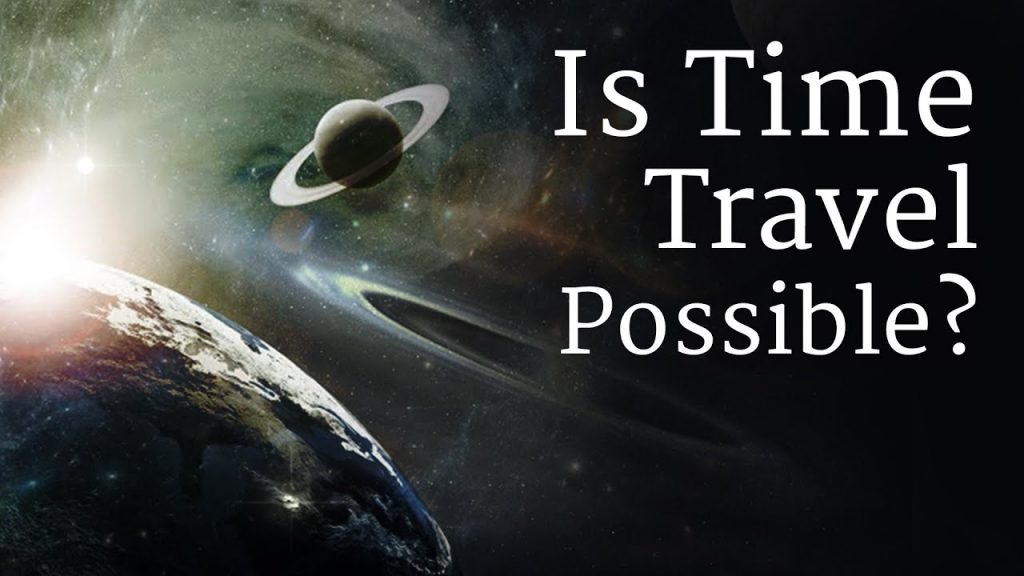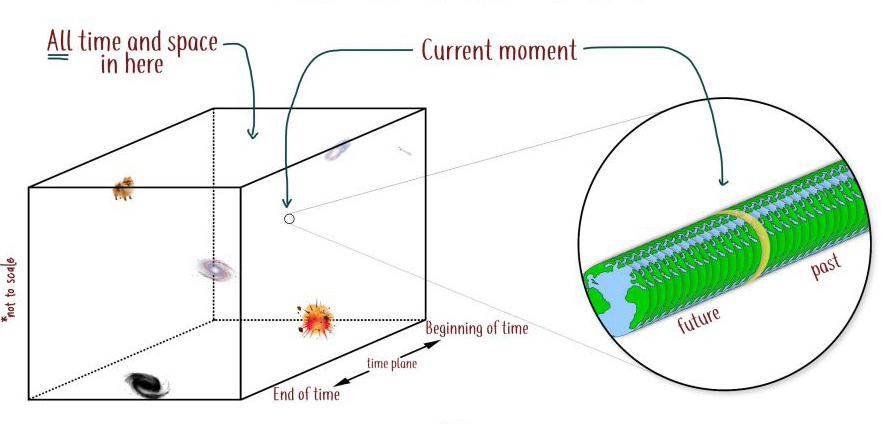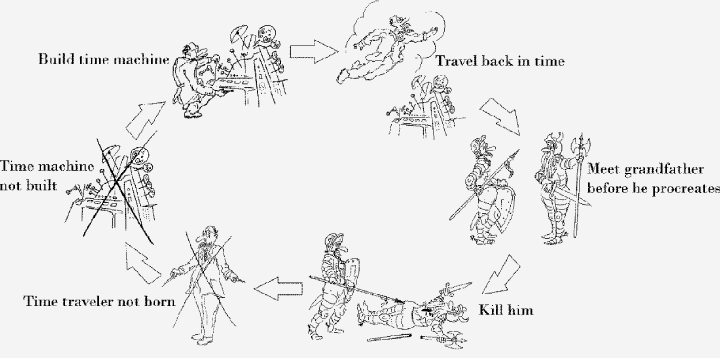Traveling back in time is next to impossible. You can’t even send information back in time because it can change things that have already happened, which is impossible. For example, you broke your leg while cycling. What if you could have traveled back in time and told yourself not to cycle that day?
If you were successful in doing so, you would never fall and break your leg, but we sometimes desire to go back in time and solve many problems.
Time travel may be a very confusing concept for all people. That’s because once we are in the present time, we expect everything to be in its right place without any issues. So if we could travel back in time and change a few things that happened before, we might change that line’s order. So, that is breaking a rule which is called causality.

By Causality, we mean it as a cause like your actions, for example, happen before an effect – the results of your actions. In our cycling example, the cause is falling; therefore, the effect is breaking your leg – which happens because you fell while cycling.
Causality is one of the rules of the universe that cannot be broken no matter what. Breaking it might have difficult consequences for the universe and everyone around us. So, scientists think that because the universe has this particular rule, traveling to the past must be just next to impossible, or else the rule would always be broken.
Many of us have this question: Can we travel back in time? This question is very difficult question to answer. Recent investigations into this question have provided evidence that the solution is usually no, but it still needs to be proven impossible. Even many physicists still study if time travel is possible, not only whether it will be possible but also how one might do the same.
Not all scientists believe that time travel could also be possible, some of them even say that an effort would be very serious to any human who chooses to undertake it.
What can we understand by Time?
While most people consider time a continuation that keeps moving forward, the famous physicist Einstein showed us that it is an illusion; it is relative. That may be different for various observers counting on your speed through space.
As per Einstein, time is known as the fourth dimension, and Space is described as a three-dimensional arena, which provides a traveler with coordinates like the length, width, and height, which show location also. Time provides another coordinate-like direction, although, being honest, as per our research, it is known that it only moves forward, and the theory says that time is real.
Einstein’s special theory of relativity says that time slows down or accelerates, counting on how briskly your progress relative to something else. Approaching the speed of sunshine, an individual inside a spaceship would age much slower than his twin, who is at his own house simultaneously. Also, Gravity can bend time according to Einstein’s general theory of relativity.

Let’s say a four-dimensional fabric is called space-time. When anything with mass sits on a piece of cloth, it may cause a dimple or a bending of space-time. The bending of space-time causes objects to be on a curved path, and that part of space is what we all know as Gravity.
The overall and special relativity theories are proven with GPS satellite technology with the correct timepieces. The consequences of Gravity, also because of the satellites’ increased speed above the world relative to observers on the bottom, make the clocks gain 38 microseconds each day.
In a sense, this effect is called time dilation, which means astronauts are time travelers, as when they return to Earth, they do return very, very younger than their identical twins or any younger sibling that remains on the Earth.
Time Travel Theories:
Popular scientist Einstein’s theories make time travel difficult, so some researchers have proposed alternate solutions to leap back and forth.

Black Holes:
Another possibility can be moving a ship around a region or artificially creating that condition with a rotating structure.
Around and around, they would go, experiencing just half the time of everyone at a distance from the very black hole. The ship and its crew could travel through time – physicist Hawking wrote in the Daily Mail around 2010.
Imagine they circled the region for about five of their years. Ten years would pass elsewhere. And once they return home, everyone on Earth will have aged five years more than they had.

However, he also said the crew would wish to travel around the speed of light for this to work out. Physicist known as Amos Iron at the Technion-Israel Institute of Technology in Haifa, Israel, acknowledged another limitation to it if one used a machine: It may break before even having the ability to rotate that quickly.
Cosmic strings:
For potential time travelers, another theory involves cosmic strings, which are narrow tubes of energy stretched across the whole length of the ever-expanding universe. These thin regions, which are left over from the first cosmos, are also known to contain huge amounts of mass and thus could warp the space around them.
According to most scientists, Cosmic strings are either infinite or they are in loops without any ends. The approach of two such strings parallel to every other would bend space-time so hard and in such a configuration that may make time travel possible in theory too.
Infinite cylinder:
Astronomer Frank Tipler proposed a mechanism known as Tipler Cylinder, where one would take matter 10 times the sun’s mass and then roll it into a very dense cylinder.
After spinning up a couple of billion revolutions per minute, a spaceship nearby, which follows a precise spiral around this cylinder, can get itself on a “closed, time-like curve,” as per the Anderson Institute. However, there are limitations to this method as well. Also, it includes the very fact that the cylinder must be long for this to figure.
The Grandfather Paradox: A Classic Time Travel Conundrum
The Grandfather Paradox is a classic time travel conundrum that raises the question of the possibility of time travel into the past. It is a paradoxical situation where an individual time traveler goes back in time and kills their grandfather before he has any children, thereby preventing their birth.

This paradox raises questions about time and causality, i.e., whether one can alter the past without changing the future. The grandfather paradox has been the subject of numerous fiction works such as movies, TV shows, books, and scientific papers.
Although the paradox remains unresolved, as time travel is still only a theoretical concept, it has fed the imagination of scientific and literary communities for decades.
Can we travel through Time Machines? Time Travel Is Possible
Normally we understand that traveling forward or back in time would require us a tool known to be a time machine to get you there, be it travel back to a time or travel forward.
Usually, machine research involves bending space and time, so that point lines turn back on themselves to make a loop which is technically referred to as a closed time-like curve.
In other words, time machines are thought to be a wish for an exotic sort of matter with so-called negative energy density. The such exotic matter has bizarre properties, including moving in the other direction than normal matter when it is pushed. Such matter could theoretically exist, but if it did, it would be present only in quantities too small for the development of a machine.
However, time travel research suggests that machines are possible without exotic matter.
The work starts with a doughnut-shaped hole enveloped within a sphere of normal matter. Inside this doughnut-shaped vacuum, space-time could get bent upon itself using focused gravitational fields to make a closed time-like curve. To go back in time, a time traveler would race around inside the doughnut, going further back into the past with each lap. This theory features several obstacles, however.
The gravitational fields required to form such a closed time-like curve would need to be strong enough, and manipulating them would need to be precise.
Conclusion:
While time travel doesn’t seem possible, the sector is constantly changing in the sense that humans would survive it with the physics we use today. Some advances in quantum theories could perhaps provide us with some understanding of overcoming time travel paradoxes soon enough.
One possibility, however, that only sometimes causes time travel is to solve the mystery of how certain particles can communicate instantaneously with one another, which is faster than the speed of light. In the meantime, however, interested time travelers can experience it differently through movies, television, and books, as what they show differs from what is in real life.
So, by this, we know Time travel may be real. But it is different from what we have seen in the movies. It is possible to experience time passing at a special rate of more than 1 second per second, and there are also some important reasons why we would like to know this world sort of time travel.
Checkout: How to Apply for a NASA Internship?
